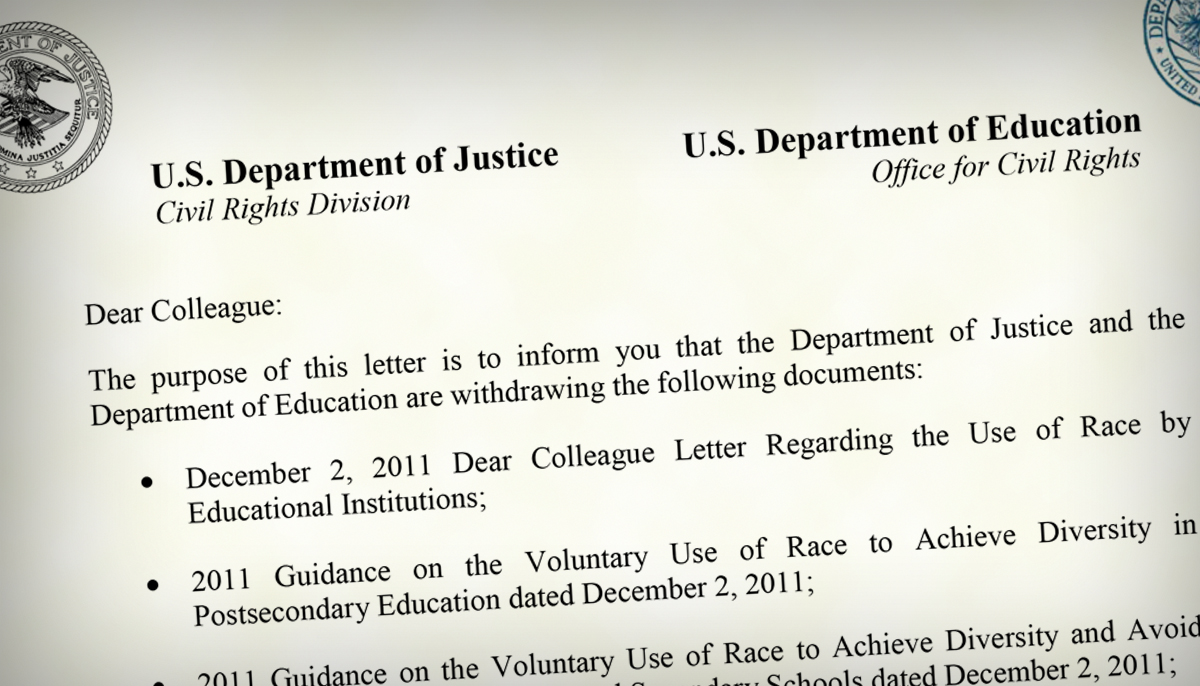
Federal agencies have the authority to promulgate rules and regulations that carry the force of law, but first they must conduct a “notice and comment” process that allows stakeholders to weigh in on the proposed changes. Ambitious agencies have managed to skirt this requirement, however, simply by issuing “guidance” that they label as mere interpretation or clarification of established law.
For decades, the worst offender has been the Office for Civil Rights (OCR) in the Department of Education. During Barack Obama’s presidency, this practice reached its apex, as OCR issued a raft of “Dear Colleague” letters and guidance documents ostensibly clarifying the law on a range of issues affecting schools—sexual misconduct, racial disparities in discipline, school resources, transgender students, and the assignment of students to schools by race. In fact, these documents sidestepped the legal process and encouraged or mandated schools to pursue policies that neither Congress nor the courts had authorized.
When Donald J. Trump took office, his Education Department (ED) began to rescind these administrative dictates. Most recently, ED withdrew several pieces of guidance on using racial criteria to promote diversity in schools, including a 2011 document, jointly issued by OCR and the Department of Justice, that encouraged school districts to take race into account when assigning students. The repeal of that guidance provoked an outcry among progressives.
The 2011 guidance had its roots in the 2007 case Parents Involved in Community Schools v. Seattle School District No. 1, in which the U.S. Supreme Court voted 5 to 4 to strike down school-integration plans that two districts had voluntarily adopted. Chief Justice John Roberts wrote for the majority, and Justice Anthony Kennedy penned a concurring opinion but noted in it that he would not go so far as the others in forbidding race-conscious policies. Justice Stephen Breyer offered the most comprehensive dissent. In response to the court’s decision, the George W. Bush administration advised schools to use race-neutral assignment policies. But in 2011, Obama’s OCR withdrew that guidance, replacing it with new advice predicated on Kennedy’s concurring opinion and Breyer’s dissent.
Trying to reconcile the two opinions was bound to fail, since Kennedy had written that Breyer’s argument “rest[ed] on . . . a misuse and mistaken interpretation of our precedents.” The core principle of Kennedy’s concurrence was that under no circumstances could school districts treat “each student in a different fashion solely on the basis of a systematic, individual typing by race.”
To be fair to OCR, Kennedy’s concurrence was opaque—but it wasn’t that opaque. He agreed that the school-integration plan in Seattle and the one in a companion case from Louisville went well beyond constitutional limits, but he also allowed that districts could, in restricted circumstances, engage in individual racial classifications to increase diversity. He added that school districts could take race into account only if they could show that they had a compelling interest in doing so. Promoting racial diversity could constitute such an interest if efforts toward integration were “narrowly tailored” and specifically grounded in a local district’s circumstances.
In its 2011 guidance, however, OCR encouraged school districts to use race in ways that would likely fall afoul of Kennedy’s concurrence. The document declared that “the Departments recognize, as has a majority of Justices on the Supreme Court, the compelling interest that K–12 schools have in obtaining the benefits that flow from achieving a diverse student body.” But in fact, OCR never defined the term “compelling interest.” Thus, any school district following the guidance risked going beyond what Parents Involved allowed—and put itself in legal jeopardy—if it could not show that local circumstances justified race-conscious policies. As well, OCR told districts that they could use race as a “plus factor” in assigning students to schools, as long as other “non-racial” considerations were also used. But they failed to explain how a racially based “plus factor” would not amount to “systematic, individual typing by race.”
With Kennedy’s retirement from the court, this whole question could be rendered moot. From all appearances, Trump’s court nominee, Brett Kavanaugh, will prove even less sympathetic to assigning students by race than was his predecessor. And Kavanaugh seems highly wary of agency efforts to expand regulatory authority beyond statutory limits. Hence, the Trump administration’s decision likely just hastened the guidance’s death and spared any district unwise enough to follow it a lengthy legal battle.
Joshua Dunn is professor of political science and director of the Center for the Study of Government and the Individual at the University of Colorado Colorado Springs.
This article appeared in the Winter 2019 issue of Education Next. Suggested citation format:
Dunn, J. (2019). Good Advice: Trump overturns Obama guidance on race in public schools. Education Next, 19(1), 7.


